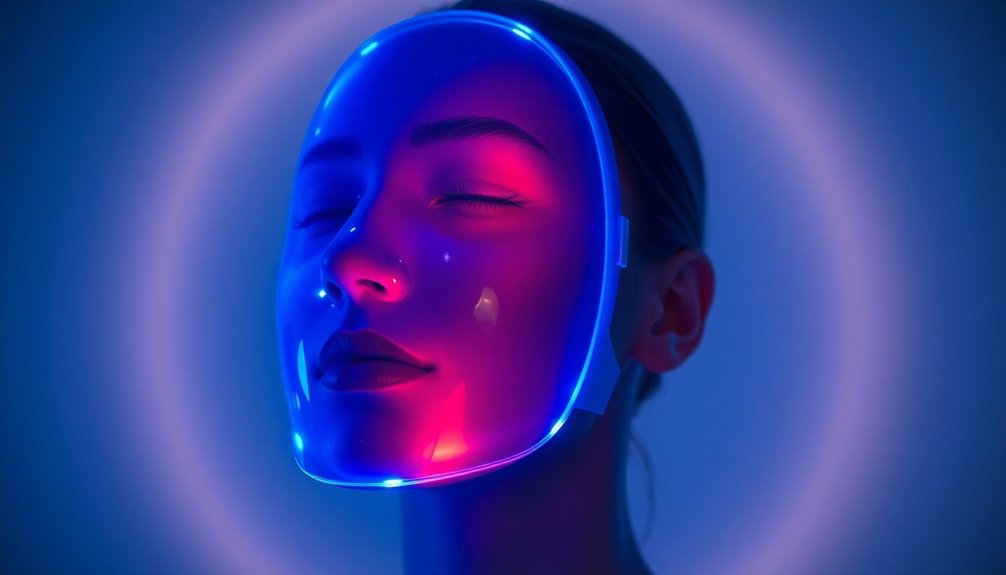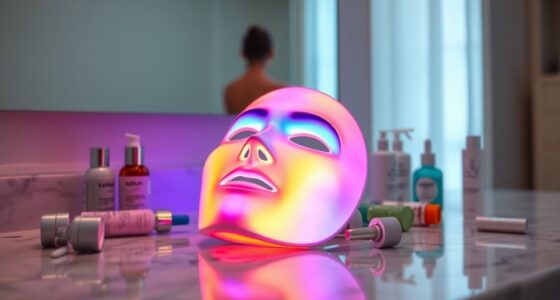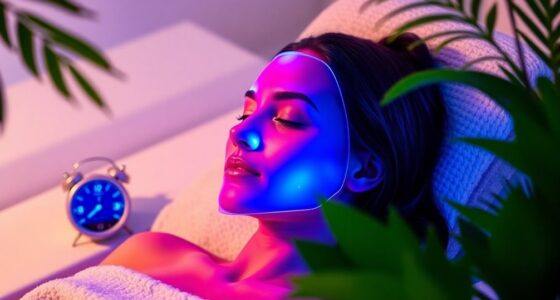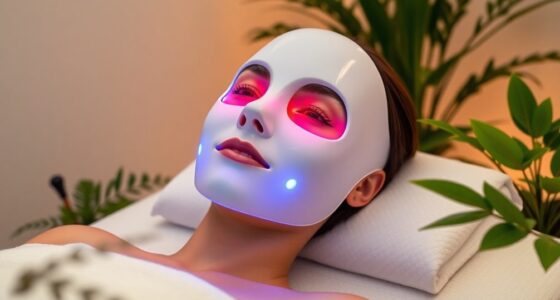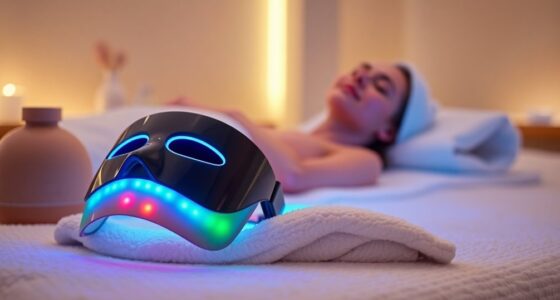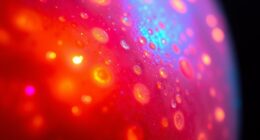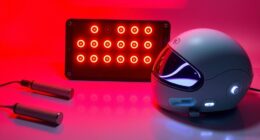LED face masks are quite effective for enhancing your skin health. They use targeted light therapy to address issues like acne, fine lines, and uneven skin tone. Red light boosts collagen production, while blue light fights acne-causing bacteria. Regular use (3 to 5 times a week) can lead to noticeable improvements in texture and tone. However, safety precautions are important to avoid side effects. If you’re curious about specific applications and benefits, continue exploring the details.
Key Takeaways
- LED face masks effectively treat acne and fine lines by using specific wavelengths of light to target skin concerns.
- Regular use, 3 to 5 times a week, is essential for achieving noticeable improvements in skin texture and appearance.
- Red light therapy enhances collagen production, while blue light therapy reduces acne-causing bacteria and oil production.
- At-home masks are less powerful than in-office treatments but can maintain results and complement professional therapies.
- Safety measures, including eye protection and skin type assessment, are vital for minimizing risks and ensuring effective outcomes.
Understanding LED Face Masks

LED face masks have become a popular skincare tool, offering a convenient way to enhance your routine. Utilizing LED light therapy, these masks emit different wavelengths of light to address various skin concerns.
For instance, red light (630-660 nm) works on wrinkles and boosts collagen production, while blue light (405-420 nm) targets acne-causing bacteria. They’re generally safe for most people, especially with FDA clearance, though you should use protective measures for blue light exposure.
Regular use—about 3 to 5 times a week—is key for noticeable improvements in skin texture and fine lines. Just keep in mind that results can vary, so it’s wise to track your progress over at least a month to truly assess effectiveness.
Mechanism of Action and Efficacy
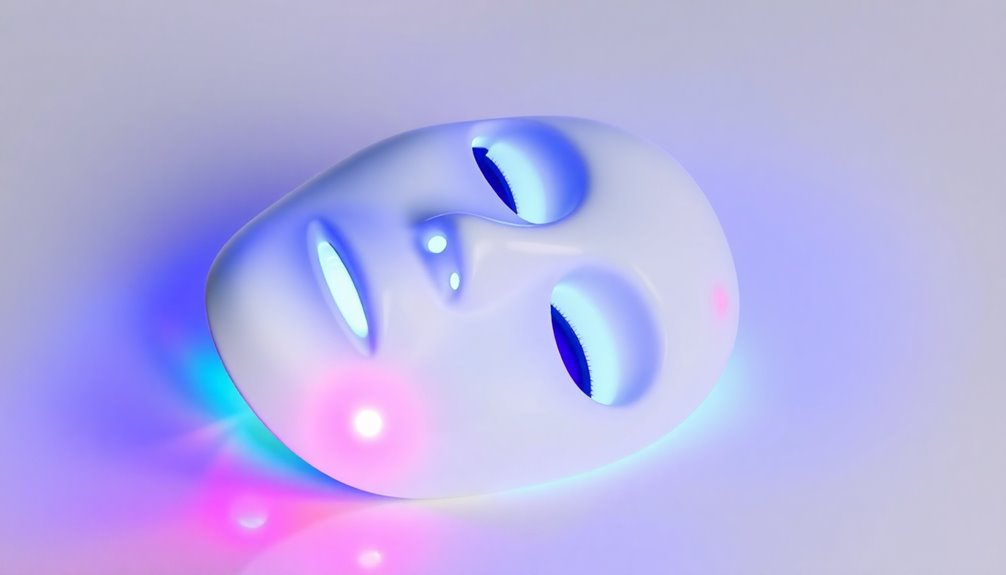
While you might be familiar with the glowing promises of LED face masks, understanding their actual mechanism of action reveals how they effectively target skin issues.
LED masks utilize specific wavelengths, like red light LED for anti-aging and blue light therapy for acne treatment, to penetrate skin layers and stimulate cellular activity.
Here’s how they work:
- Red Light LED: Enhances collagen production, reduces inflammation, and improves skin elasticity.
- Blue Light Therapy: Targets acne-causing bacteria, helping regulate oil production and minimize breakouts.
- Clinical Studies: Show consistent use leads to subtle improvements in skin texture and a decrease in wrinkles over time.
Keep in mind that at-home devices are less powerful than professional ones, requiring regular use for noticeable results.
Treatment Applications and Benefits

When you use LED face masks, you can tackle various skin conditions like acne, fine lines, and rosacea without invasive procedures.
The non-invasive nature of these treatments makes them a popular choice for improving skin health.
With consistent use, you might notice significant improvements in your skin’s appearance and texture.
Skin Conditions Treated
Many people find LED face masks effective for treating various skin conditions, as these devices utilize specific wavelengths of light to promote healing and rejuvenation.
Here are three skin conditions that can benefit from LED therapy:
- Acne: Blue light therapy targets acne-causing bacteria, helping to reduce lesions and prevent future outbreaks.
- Fine Lines and Wrinkles: Red light therapy stimulates collagen synthesis, enhancing skin elasticity and reducing the appearance of wrinkles.
- Rosacea: LED face masks can help decrease inflammation and improve overall skin tone.
Regular use can lead to noticeable improvements in skin texture over time, making LED face masks a safe and effective option for various skin types. Additionally, the nutritional benefits of certain ingredients in skincare products can complement the effects of LED therapy.
Experience the benefits for yourself and enjoy healthier, rejuvenated skin!
Non-Invasive Benefits
LED face masks offer a range of non-invasive benefits that go beyond treating specific skin conditions. With LED therapy, you can improve your skin texture while enjoying a relaxing treatment.
Red light therapy boosts collagen production, reducing fine lines and wrinkles, while blue light therapy targets acne-causing bacteria, helping to minimize breakouts. Regular use—typically 3 to 5 times a week—can lead to subtle yet noticeable improvements over time.
Many users report enhanced skin texture and a more radiant complexion. Because these masks are non-invasive, you don’t have to worry about downtime or harsh side effects.
Safety, Risks, and Limitations

When using LED face masks, it’s important to take into account safety and individual skin differences.
Some potential side effects, like redness or inflammation, can occur, especially if you misuse the device.
If you have darker skin or light sensitivity, consulting a dermatologist before starting treatment is a smart move.
General Safety Considerations
Although LED face masks are generally safe for most users, it’s important to contemplate individual circumstances before using them. Here are some safety considerations to keep in mind:
- Light Sensitivity: If you have light sensitivity, consult a dermatologist before using an LED mask, as it might exacerbate your condition.
- Eye Protection: Always wear eye protection during treatments, especially with blue light therapy, to shield your eyes from potential damage caused by spillover light.
- Skin Tone: Those with darker skin tones should proceed with caution, as they may be at a higher risk of discoloration. It’s wise to consult with a skincare professional beforehand.
Potential Side Effects
While many users find LED face masks beneficial, it’s vital to be aware of potential side effects that can arise from their use. Common side effects include irritation, redness, and increased inflammation, especially if you overuse the device or don’t follow the manufacturer’s instructions.
If you have light sensitivity or specific skin conditions, you should consult a dermatologist before starting treatment. Eye protection is important during sessions, particularly with blue light, as extended exposure might lead to vision issues.
Individuals with darker skin tones should exercise caution, as LED therapy may trigger discoloration or exacerbate issues like melasma and hyperpigmentation. Always assess your skin type and adapt your use accordingly to minimize risks.
Individual Skin Variability
Understanding individual skin variability is essential for maximizing the effectiveness of LED face masks. Your skin type, age, and existing conditions can greatly influence how well you respond to treatment.
Here are three key points to take into account:
- Darker skin tones may be more prone to discoloration and may not respond ideally to certain wavelengths.
- Sensitive skin can experience side effects like inflammation or redness, making personalized assessments important.
- Consulting a dermatologist guarantees the LED device you choose is suitable for your unique skin profile.
Recognizing these factors can help you achieve better results and minimize risks.
It’s crucial to approach LED therapy with an understanding of your individual skin variability for safe and effective outcomes.
At-Home Masks vs. In-Office Treatments

When considering LED face masks, you’ll find a significant difference between at-home options and in-office treatments.
At-home masks operate at lower energy levels, requiring regular use—three to five times a week—to achieve visible improvements. In contrast, in-office treatments deliver more powerful doses of light and have been extensively studied, leading to noticeable results after fewer sessions.
While at-home masks can complement professional treatments and help maintain results, they typically won’t match the immediate effectiveness of in-office sessions.
For the best outcomes with at-home devices, consistency and proper technique are essential. Make certain the mask is in close contact with your skin and follow the manufacturer’s guidelines for ideal light absorption and treatment duration.
Future Trends and Research
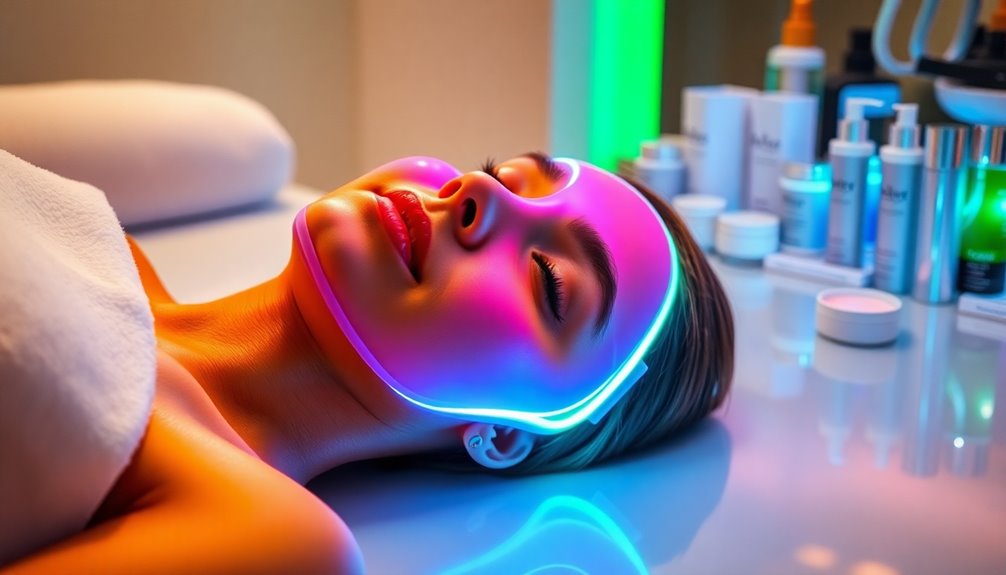
As LED light therapy gains popularity in both at-home and professional settings, ongoing research is expanding its applications beyond traditional skincare.
You’ll likely see advancements that include:
- Broader Medical Applications: Researchers are exploring LED light therapy for pain management and other medical conditions.
- Innovative At-Home Devices: The demand for non-invasive solutions is pushing for the development of more advanced at-home devices tailored to individual skin concerns.
- Combination Treatments: Studies are investigating the synergy of LED therapy with treatments like chemical peels and microdermabrasion for enhanced skin health.
Future clinical trials will focus on establishing safety protocols and long-term effectiveness across diverse skin types, making LED light therapy even more appealing and reliable for consumers like you.
Frequently Asked Questions
Do LED Light Masks Really Work?
Do LED light masks really work? Yes, they can show subtle improvements in your skin’s texture and wrinkles with regular use. However, the results can vary depending on individual skin types and the specific conditions being treated. Many users report an overall enhancement in skin clarity and a reduction in inflammation after consistent use. For a more detailed understanding of their benefits, you can consult a led light masks effectiveness review, which evaluates various models and their performance based on user experiences.
You’ll need to use them consistently—about 3 to 5 times a week—to see the best results.
While they mightn’t be as powerful as professional treatments, many users find them effective for enhancing collagen production and reducing inflammation.
Just remember to protect your eyes, especially with blue light therapy.
What Does the Mayo Clinic Say About Red Light Therapy?
The Mayo Clinic acknowledges red light therapy as a promising non-invasive treatment for improving skin texture and reducing fine lines.
It stimulates collagen production, which can enhance your skin’s appearance. While it’s generally safe, it’s wise to consult a healthcare professional, especially if you have sensitive skin or specific conditions.
Consistent use is key, as results may take time to show, and outcomes can vary based on individual skin types.
What Are the Disadvantages of LED Face Masks?
When considering LED face masks, you should be aware of several disadvantages.
The results can vary greatly, so you mightn’t see the improvements you hope for. Some masks can cause irritation or redness, especially if you overuse them or have sensitive skin.
Additionally, the lack of long-term safety data means you could be unsure about their effects over time.
Finally, high-quality options can be quite expensive, raising questions about their value.
How Long Does It Take to See Results From a LED Mask?
Think of your skin like a garden; it needs time and care to flourish.
When using an LED mask, you might start noticing subtle improvements in skin texture and fine lines within 2 to 4 weeks, especially if you’re consistent.
However, for more significant changes, like improved elasticity, it often takes a couple of months.
Keep track of your progress with photos, as patience is key to seeing the best results.
Conclusion
In the domain of skincare, LED face masks shine like beacons of hope, illuminating your path to healthier skin. While they offer promising benefits and a touch of futuristic charm, remember they’re not a magic wand. Weigh the safety and efficacy of at-home devices against professional treatments. As research continues to unfold, you’re poised to embrace a brighter future for your complexion. So, step into the glow and discover what works best for you!
